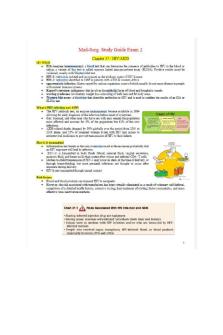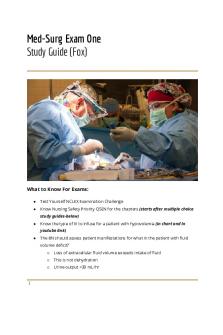MED SURG 2 first study guide PDF

| Title | MED SURG 2 first study guide |
|---|---|
| Author | Tiffany Tripodi |
| Course | Nursing Care Of Adults Ii |
| Institution | Adelphi University |
| Pages | 20 |
| File Size | 512.2 KB |
| File Type | |
| Total Downloads | 51 |
| Total Views | 134 |
Summary
first exam study guide...
Description
Oncology
Cancer Development Understanding of Key terms in Oncology & how they affect the body
Hyperplasia – abnormal overgrowth of tissue caused by an increase in the number of cells Metaplasia – replacement of one differentiated adult cell type with another that does not normally occur in the tissue in which it is found; may precede development of Ca Dysplasia – abnormal changes in cell size, shape, appearance, or organization from other cells in the tissue; may precede development of Ca Anaplasia – irreversible loss of differentiated cellular morphology; a feature of malignant cells Neoplasia – abnormal cell growth not needed for normal development or replacement of dead or damaged tissues; Always develop from normal parent cells. May be benign or malignant.
Characteristics of Benin & Malignant Tumors
Carcinogenesis/Malignant transformation Malignant transformation – the process of changing a normal cell into a cancer cell. Involves mutation of the genes (DNA) of normal cell Only takes transformation of one normal cell for cancer to begin Cancer can develop in any tissue or organ but tends to occur more commonly in tissues that continue to grow by cell division (mitosis) throughout the life span. 1. Initiation begins the change of a normal cell into a cancer cell. 2. Promotion is the enhancement of growth of an initiated cell; “promoters”
3. Progression is the continued change of a cancer, making cells more malignant; angioneogenesis 4. Metastasis is the spread of a tumor or cancer cells from the original site. ◦ Metastasis – lymphatic & blood borne (hematogenous)spread ◦ Primary tumor (original site) and secondary tumor (metastatic site) Even though the tumor is now in another organ, it is still a cancer from the original altered tissue Primary Tumor (T)
Regional Lymph Nodes (N)
Distant Metastasis (M)
T = the extent of the primary tumor
N = the absence or presence of regional lymph node metastasis
M = the absence or presence of distant metastasis
Tx = primary tumor cannot be assessed
Nx = regional lymph nodes cannot be assessed
Mx = presence of distant metastasis cannot be assessed
T0 = no evidence of primary tumor
N0 = no regional lymph node metastasis
M0 = no distant metastasis
Tis = carcinoma in situ (no spread)
N1, N2, N3 = increasing involvement of regional lymph nodes
M1 = distant metastasis
T1, T2, T3, T4 = increasing size and/or local extent of the primary tumor Carcinogens – substances that can damage normal cell DNA and change the activity of genes; initiate or promote cellular transformation TNM staging Grading Grading of a tumor classifies cellular aspects of the cancer (pathologic classification of tumor cells)– Grades I to IV
Cancer Prevention – Primary (risk factors, prevention strategies; Secondary (screening guidelines);
PRIMARY: sun screen, smoking cessation Modification of associated factors – limit alcohol, lose/maintain healthy weight low-fat/high fiber diet, safe sex/limit partners, get off the couch Removal of “at-risk” tissues – remove moles, polyps, breasts Chemoprevention – tamoxifen, Evista, vit D (breast); ASA & Celebrex(colon); lycopene (prostate) Vaccination – Gardasil (HPV); HBV
SECONDAY:
Yearly mammograms ages 40-54; every 2 yrs age 55+ Yearly clinical breast exams for women over 40; every 3 yrs ages 20-30 PAP test every 3 yrs – ages 21-29
PAP ad HPV every 3 yrs – ages 30-65; D/C after age 65 if 3 negative PAPs 2 negative HPV tests in past 10 years with most recent test in past 5 years. Colonoscopies at age 50 and every 10 yrs after Yearly Guaiac FOBT or FIT (fecal immunochemical test) for all age 50+ Yearly prostate-specific antigen (PSA) test and digital rectal examination for men 50 years and older. Genetic screening – BRCA 1 (breast & ovarian); BRCA 2 (breast); APC, MLH1 & 2 (colon)
TERTIARY (recurrent & secondary malignancies)
Monitoring for & preventing recurrence of the primary cancer and screening for development of second malignancies in cancer survivors Lymphoma and leukemia have been associated with certain chemotherapy agents and the use of radiation therapy Survivors may also develop second malignancies not related to treatment but genetic mutations related to inherited cancer syndromes, environmental exposures, and lifestyle factors.
Dietary habits to reduce cancer risk Avoid excessive intake of animal fat Avoid nitrites Minimize intake of red meat Minimize alcohol consumption Increase intake of bran Increase intake of cruciferous vegetables (broccoli, brussel sprouts, cauliflower, cabbage) Increase intake of foods high in Vitamin A (apricots, carrots, leafy green and yellow vegetables) and Vitamin C (citrus fruits, fresh vegetables)
Warning Signs of Cancer ** CAUTION US **
Care of Pts. With Cancer Radiation Therapy (external & internal/brachytherapy – sealed & unsealed) Teletherapy/EBRT (external) – radiation delivered from source outside the patient patient is not radioactive. (higher energy and deeper penetration- daily doses = fractions.) Brachytherapy (internal) – radiation source comes into direct, continuous contact with the tumor tissue for a specific time period – patient is radioactive for a period of time. (when pt. is in contact, they are radioactive.) Unsealed radiation source (isotopes) – excreta (waste) are radioactive, not the patient Sealed radiation source (implants) – the patient is radioactive, but not excreta side effects Altered skin/mucosal integrity: radiation dermatitis (local skin changes) and alopecia Stomatitis (oral), mucositis (lining of GI tract), altered taste sensations – often of red meat Fatigue related to increased energy demands – often debilitating Inflammatory responses that cause tissue fibrosis and scarring of normal tissue – dysphagia, chest pain
Bone marrow suppression – anemia, leukopenia, thrombocytopenia – increased risk for infection & bleeding Late effects (6 mo. to years after Tx) – chronic, may be severe fibrosis, atrophy, ulceration & necrosis affecting lungs, heart, CNS, bladder; dysphagia, incontinence, cognitive impairment, sexual dysfunction Other long-term permanent effects Radiation to the throat and upper chest – swallowing difficulty and reduced nutrition Radiation to head and neck – xerostomia and tooth decay Radiation to bone – prone to fracture
implications for care of pts./pt. education
Wash irradiated area gently each day with lukewarm water, using hand rather than washcloth, and rinse thoroughly Use only powders, lotions, creams that are approved by the radiation oncology department Take care not to remove any ink markings that mark where the radiation beam will go Dry irradiated area with patting motions using soft clean towel Avoid rubbing, scratching, hot water/heating pads, ice, shaving, adhesive tapes; do not disrupt blisters Wear soft clothing over the radiation site; avoid belts, buckles, straps Avoid exposure of irradiated skin to sun – Keep covered – No Sunscreen Avoid sun/heat exposure – avoid outdoors between 10 am & 4 pm OR stay in shaded area
Care for patients with implanted radiation Assign pt. to private room with bathroom Place sign on patient’s door “Caution: Radioactive Material” Keep door to room closed Wear dosimeter film badge at all times while caring for patient Wear lead apron, don’t turn back to radiation source Pregnant nurses should not care for patient. No pregnant visitors or children under 16 Limit visitors to 30 minutes/day and instruct them to stay 6ft away from source Don’t touch radioactive source with bare hands. Use long handled forceps and place in lead container in room Save all dressings and bed linens in room until source is removed or radiation has dissipated
Chemotherapy – Side effects Temporary and permanent physical damage can occur to normal tissues (can be minimized by administering cytoprotectants with or prior to chemo) Anorexia, Nausea & Vomiting (CINV-chemotherapy induced N&V) Stomatitis & Mucositis Alopecia (chemo & whole brain radiation) Skin changes Changes in cognitive function – “chemo brain” Anxiety/sleep disturbances Altered bowel elimination Chemotherapy-induced neurotoxicity (CIN); Peripheral neuropathy *Bone Marrow Suppression* can be life threatening and is the most common reason for changing the dosage or the schedule of chemotherapy – ANT: Anemia, Neutropenia,
Thrombocytopenia (bone marrow – produce blood cells) Patient-Centered Nursing Care – Chemotherapy Infection risk!!! Chemotherapy-induced nausea and vomiting (CINV) Stomatitis/Mucositis – avoid commercial mouthwashes, foods that are spicy, hard to chew, too hot or cold foods, alcohol, tobacco; Use normal saline rinses, lip lubricant, topical anesthetics, small, frequent meals -liquid/puree diet/supplements, soft brushing; ensure proper denture fit-remove when not eating Alopecia – avoid sun/cover scalp; new hair color may differ; cut long hair before Tx; wigs Changes in cognitive function (“chemo brain”) Chemotherapy-induced neurotoxicity – affect CNS, PNS, &/or cranial nerves Metabolic encephalopathy – methotrexate Peripheral neuropathy – (comes on rapidly, tingling, loss of sensation, burning) – vincristine; oxaliplatin (Cisplatin-unique neuro toxicity -- exposure to cold, pharyngeal/laryngeal discomforting sensation. NO cold fluids or having them go outside b.c it will exacerbate their symptom. Also, can get hearing loss) (can also have lack of taste, constipation, sexual dysf., orthostatic hypotension, CIPN – can be PERMAMNENT in some people L ) Bone marrow suppression (A-N-T); BMS... Also, called myelosuppression, pancytopenia Anemia (decreased red blood cells): causes hypoxia, fatigue Neutropenia (decreased WBC’s/neutrophils): increases risk of infection Thrombocytopenia (decreased platelets): increased risk of bleeding Most common infections: fungal, bacterial or viral *Most infections during neutropenia result from overgrowth of the patient’s own normal flora* Administration of biological response modifiers (BRM’s) and growth factors can help minimize risk of infections (Neupogen,, Neumega, Neulasta) Epogen, Procrit, Aranesp)
Nursing considerations/Neutropenic precautions
Hand hygiene Private room when possible Single use supplies/equipment, dedicated equipment Limit number of health care personnel in room Monitor VS, lung sounds, access sites every 4 hrs Inspect pt.’s mouth and skin and mucous membranes every 8hrs Change IV tubing, wound dressings daily/ obtain specimens of any suspicious areas for cultures Encourage coughing and deep breathing, activity as tolerated Use strict aseptic technique for all invasive procedures Avoid use of indwelling urinary catheters Keep fresh flowers, plants out of room Teach pt. to avoid eating raw fruits and vegetables, undercooked meat, eggs, fish; avoid pepper and paprika Monitor pt.’s white blood cell count ◦ esp. ANC (absolute neutrophil count – NML 2500-6000) ◦ 100 degrees F, persistent cough, pus or foul smelling drainage from anywhere, presence of boil or abscess, cloudy or foul smelling urine Take all prescribed drugs Wear clean disposable gloves under gardening gloves (or don’t garden) Use condom when having sex Nursing considerations. Thrombocytopenia precautions Protect patient from bleeding & injury – Maintain safe environment Handle pt. gently Use lift sheet when moving and positioning pt. in bed Avoid IM injections and vein punctures (if necessary, use small gauge needle) Apply firm pressure to needle stick sites for at least 10 minutes or until oozing stops Apply ice to areas of trauma Test urine and stool for occult blood Observe IV sites for bleeding Instruct pt. to notify nurse if any trauma occurs or if bleeding/bruising is noted No rectal temps or enemas/ if suppository is necessary, lubricate well Measure abd. girth daily – because of internal bleeding. (body marker or tape *umbilicus*) Use electric razor instead of razor Use soft-bristled toothbrush or sponge, make sure dentures fit and don’t rub Instruct pt. not to blow nose or insert anything in nose Instruct pt. to wear shoes with firm soles when ambulating Keep pathways clear and uncluttered pt. education when thrombocytopenic; NORMAL COUNT: 150,000 – 400,000...
Similar Free PDFs
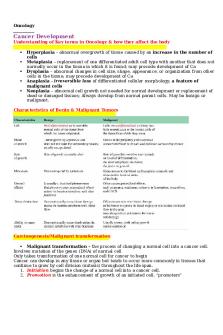
MED SURG 2 first study guide
- 20 Pages

Med Surg 2 Final Study Guide
- 25 Pages

Med Surg Study guide Notes
- 66 Pages
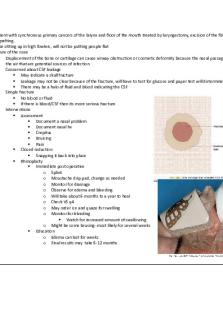
Med Surg II - Exam 2 Study Guide
- 57 Pages

Med Surg 2 Exam 3 Study Guide
- 22 Pages

Med-Surg Test #2 Study Guide
- 10 Pages

Med Surg 2 Study Guide Answer Key
- 145 Pages
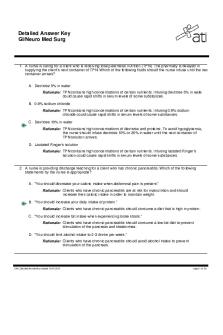
Ati gi med surg - Gi study guide
- 53 Pages

Med surg exam 1 study guide
- 25 Pages
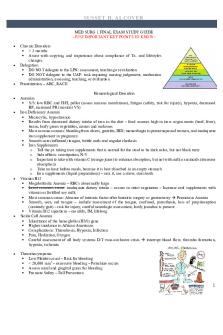
MED SURG 1 Final EXAM Study Guide
- 10 Pages

Med surg exam 3 study guide
- 68 Pages
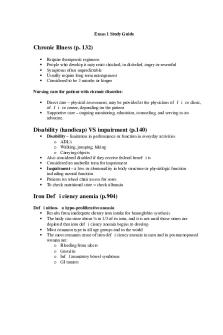
Exam 1 Study Guide - Med-Surg
- 26 Pages
Popular Institutions
- Tinajero National High School - Annex
- Politeknik Caltex Riau
- Yokohama City University
- SGT University
- University of Al-Qadisiyah
- Divine Word College of Vigan
- Techniek College Rotterdam
- Universidade de Santiago
- Universiti Teknologi MARA Cawangan Johor Kampus Pasir Gudang
- Poltekkes Kemenkes Yogyakarta
- Baguio City National High School
- Colegio san marcos
- preparatoria uno
- Centro de Bachillerato Tecnológico Industrial y de Servicios No. 107
- Dalian Maritime University
- Quang Trung Secondary School
- Colegio Tecnológico en Informática
- Corporación Regional de Educación Superior
- Grupo CEDVA
- Dar Al Uloom University
- Centro de Estudios Preuniversitarios de la Universidad Nacional de Ingeniería
- 上智大学
- Aakash International School, Nuna Majara
- San Felipe Neri Catholic School
- Kang Chiao International School - New Taipei City
- Misamis Occidental National High School
- Institución Educativa Escuela Normal Juan Ladrilleros
- Kolehiyo ng Pantukan
- Batanes State College
- Instituto Continental
- Sekolah Menengah Kejuruan Kesehatan Kaltara (Tarakan)
- Colegio de La Inmaculada Concepcion - Cebu


